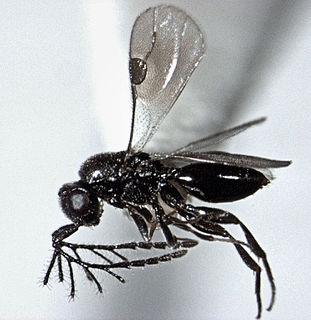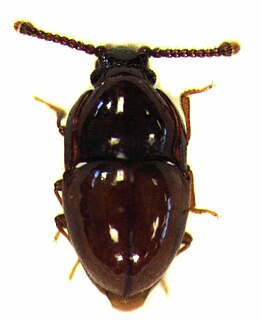
Herring are forage fish, mostly belonging to the family of Clupeidae.

The Melanoplinae are a subfamily of grasshoppers in the family Acrididae. They are distributed across the Holarctic and Neotropical realms. They are one of the two largest subfamilies in the Acrididae. As of 2001 the Melanoplinae contained over 800 species in over 100 genera, with more species being described continuously.

The Megaspilidae are a small hymenopteran family with 13 genera in two subfamilies, and some 450 known species, with a great many species still undescribed. It is a poorly known group as a whole, though most are believed to be parasitoids, and a few hyperparasitoids. Many are found in the soil, and of these, a number are wingless.

Cryptophagidae is a family of beetles with representatives found in all biogeographic realms. Members of this family are commonly called silken fungus beetles and both adults and larvae appear to feed exclusively on fungi although in a wide variety of habitats and situations, such as rotting wood and shed animal fur and feathers. These beetles vary from about 1 to 11 millimeters long, and usually have an oval body shape with a slight "waist".

Anthribidae is a family of beetles also known as fungus weevils. The antennae are not elbowed, may occasionally be longer than the body and thread-like, and can be the longest of any members of Curculionoidea. As in the Nemonychidae, the labrum appears as a separate segment to the clypeus, and the maxillary palps are long and projecting.
The National Biodiversity Network (UK) (NBN) is a collaborative venture set up in 2000 in the United Kingdom committed to making biodiversity information available through various media, including on the internet via the NBN Atlas—the data search website of the NBN.
The World Register of Marine Species (WoRMS) is a taxonomic database that aims to provide an authoritative and comprehensive list of names of marine organisms.

Clivina is a genus of ground beetle native to the Palearctic, the Nearctic, the Near East and North Africa. There are at least 580 described species in Clivina.

The Ropalomeridae are a family of acalyptrate flies.

Melanoplini is a tribe of spur-throated grasshoppers in the family Acrididae. There are about 19 genera and more than 200 described species in Melanoplini, all in North America. Their biogeography shows that many species in the tribe have descendants from the Eocene epoch and Miocene epoch.
Oedaleonotus orientis is a species of spur-throated grasshopper in the family Acrididae. It is found in North America.

Oedaleonotus is a genus of spur-throated grasshoppers in the family Acrididae. There are about nine described species in Oedaleonotus.

Aeoloplides is a genus of spur-throated grasshoppers in the family Acrididae. There are about nine described species in Aeoloplides.

Oedaleonotus borckii is a species of spur-throated grasshopper in the family Acrididae. It is found in North America.
Aeoloplides tenuipennis, known generally as the narrow-winged saltbush grasshopper or narrow-winged bush grasshopper, is a species of spur-throated grasshopper in the family Acrididae. It is commonly found in eastern California, Arizona and southwestern New Mexico north through Utah and southern Nevada to southern Idaho.
Oedaleonotus pacificus is a species of spur-throated grasshopper in the family Acrididae. It is found in North America.

Oedaleonotus enigma, the valley grasshopper, is a species of spur-throated grasshopper in the family Acrididae. It is found in North America.

Synchroa is a genus of synchroa bark beetles in the family Synchroidae. There are about six described species in Synchroa.
Animal Ethics is a nonprofit organization formed to promote discussion and debate around issues in animal ethics and to provide information and resources for animal advocates. They also do outreach work in several countries on the issue of speciesism. Their aim is to create a world where moral consideration is extended to all sentient beings. The organization's website covers topics such as speciesism, sentience, veganism and wild animal suffering and has content translated into several languages.











